
One of the more rewarding benefits of working on the “Mailin’ It” podcast is that I get to have serious (well, semi-serious) conversations with lots of interesting people who have direct impact on the Postal Service’s connection with the American public and our culture.
A perfect example of this is a recent episode my colleague, Yasmine Di Giulio, and I had with Alison Bazylinski, Assistant Curator at Smithsonian’s National Postal Museum.
Alison broke down for us how the iconic blue and ‘cadet grey’ Postal Service uniform came to life and how it became synonymous with the Postal Service’s reputation for integrity, professionalism, and commitment to public service. Alison also gave us insight into how society shaped our uniform’s evolution from its semi-military origins to today’s more casual, and practical, outfit.
Our “Mailin’ It” podcast with Alison is one you should not miss. And, to help you along, here are archival photographs you can use to visualize Alison’s descriptions.
You can also find out more about Postal Service uniforms, as well as USPS’s singular bond with the American public, at the Smithsonian’s National Postal Museum.
More details on the history of the letter carrier uniform can also be found on the Postal History webpages on usps.com.
Dale Parsan
Manager Strategic Business Planning
PICTURES AND CAPTIONS
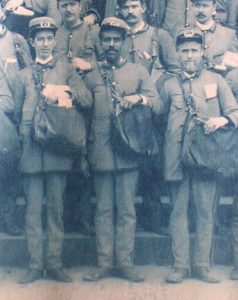
The iconic blue and cadet grey uniform was introduced in 1868. The first uniforms, as seen in this photograph from 1888, mirrored the men’s business dress fashion of the day. With no access to mass production or standard sizing, early uniforms were made by local tailors guided by instructions provided by the Postmaster General.
Collection of USPS.
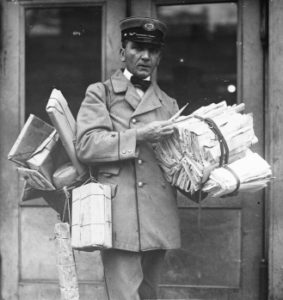
In 1899, the Post Office Department authorized the use of stars on a letter carrier’s coat sleeve to recognize long service. Different colors and numbers of stars could be added to recognize 5 to 40 years’ service, in increments of five years. By the late 1950s, 50 years’ service could also be commemorated.
source: Library of Congress collection.
https://www.loc.gov/pictures/item/2016892840/
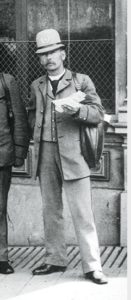
This San Francisco letter carrier from the 1890s is wearing a helmet first approved for use in 1887. Shirts were light gray or blue and were worn with a dark tie.
In a major victory for postal workers, beginning in 1901, carriers were allowed to take off their coat in hot weather.
Collection of USPS Historian, #2731.
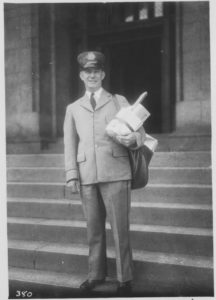
This picture from the early 1940s shows a letter carrier wearing a single-breasted summer-weight coat and a gray bell crown cap with a ventilated black cane band.
Collection of USPS Historian, #2736a.
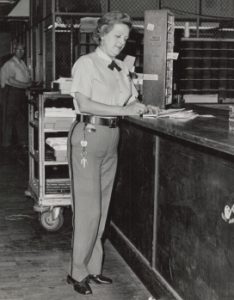
From 1887 to 1982, a numbered badge was part of the official letter carrier uniform. After hats were made optional in 1972, the badge was sometimes worn over the left breast of outerwear or in plain view on a carrier’s belt.
Collection of USPS.
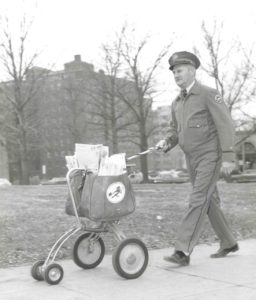
The letter carrier is wearing an Eisenhower-style jacket, which was officially introduced in 1953. The jacket takes its name from U.S. General Dwight D. Eisenhower, who famously wore this type of jacket during World War II.
Collection of USPS Historian, #395.
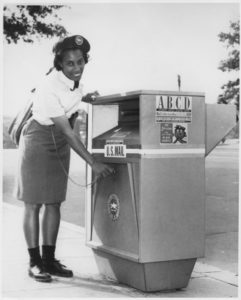
In the 1950s, a skirt was added to the official letter carrier uniform, for women carriers. Shirts, slacks, and jackets tailored for women, along with special caps, first became available in 1964.
Collection of USPS.
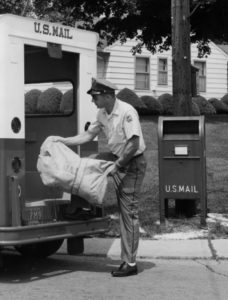
Short sleeves were authorized in 1944. In 1956, emblem patches were first added to the uniform — initially featuring the Post Office Department’s horse and rider seal.
The horse appeared to be running backward, as seen on the sleeve of this letter carrier’s uniform.
Collection of USPS.
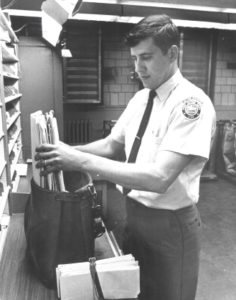
Uniform emblem patches were updated in 1965. The direction of the horse was flipped to appear to be racing forward, and a craft tab with the words “Letter Carrier” was added above the emblem patch.
Collection of USPS.
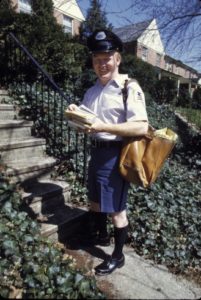
This photograph was taken in 1973, the first-year letter carriers were authorized to wear shorts. This adoption of more comfortable clothing marked a general societal trend toward casual clothing.
Collection of USPS.
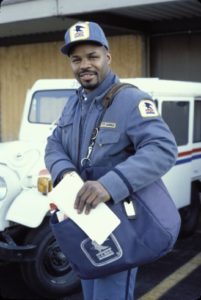
Embracing functionality and comfort, baseball-style caps were introduced to the uniform in 1982.
Collection of USPS.

Functionality, comfort, and durability were the focus of this uniform update in the 1990s, when outerwear also changed to navy blue. The refreshed “sonic eagle” corporate logo first appeared on the letter carrier uniform in 1995.
Collection of USPS; Gerald Merna, photographer.
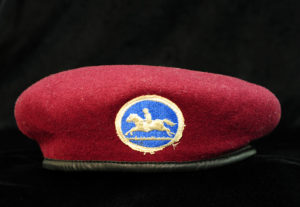
Hats have always been an important part of the letter carrier uniform and were mandated until 1972. Hats have evolved with the years and seasons and included caps, straw Panama-style hats, Safari-style “pith” helmets, fur caps for winter wear, baseball caps and this maroon woolen women’s beret.
Collection of USPS.